The Gupta dynasty is an important dynasty which ruled ancient India between 4th century to 6th century. They have left amazing examples of their glorious reign which has been called the ‘Golden era’ of India’s history. During their rule art, sculpture, inventions, philosophy,mathematics and literature has flourished. The Kingdom was founded by Sri Gupta. Chandragupta I, Samudragupta and Chandragupta II were famous kings.
Their art astonishes the onlooker and the serious art history student to this day.At Ajanta in Maharashtra are caves which have rock architecture along with painted walls and ceilings. A typical Gupta structure are chaitya halls and viharas for Buddhist monks in the form of a monastery. The painted murals in the interiors of these caves are now world famous. Stone figures, terracotta reliefs have also been created during the Gupta period. The Gandhara and Mathura schools reached greater heights during this period.
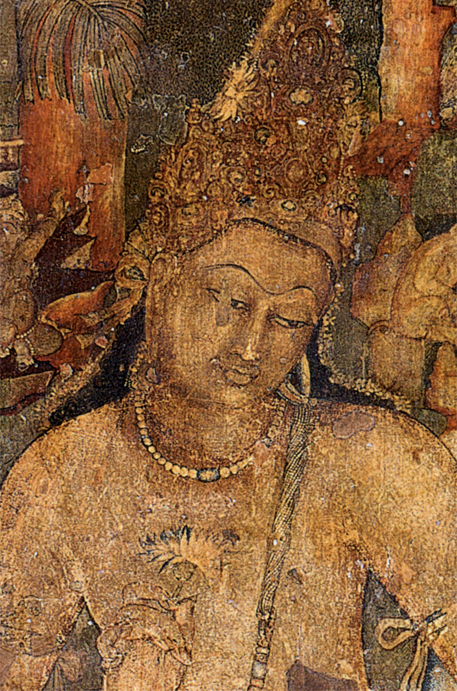
Padmapani, painting,Ajanta caves,Gupta period.
By Unknown – http://www.national-geographic.ru/ngm/200801/article_168/gallery_1394/, Public Domain, https://commons.wikimedia.org/w/index.php?curid=3411328
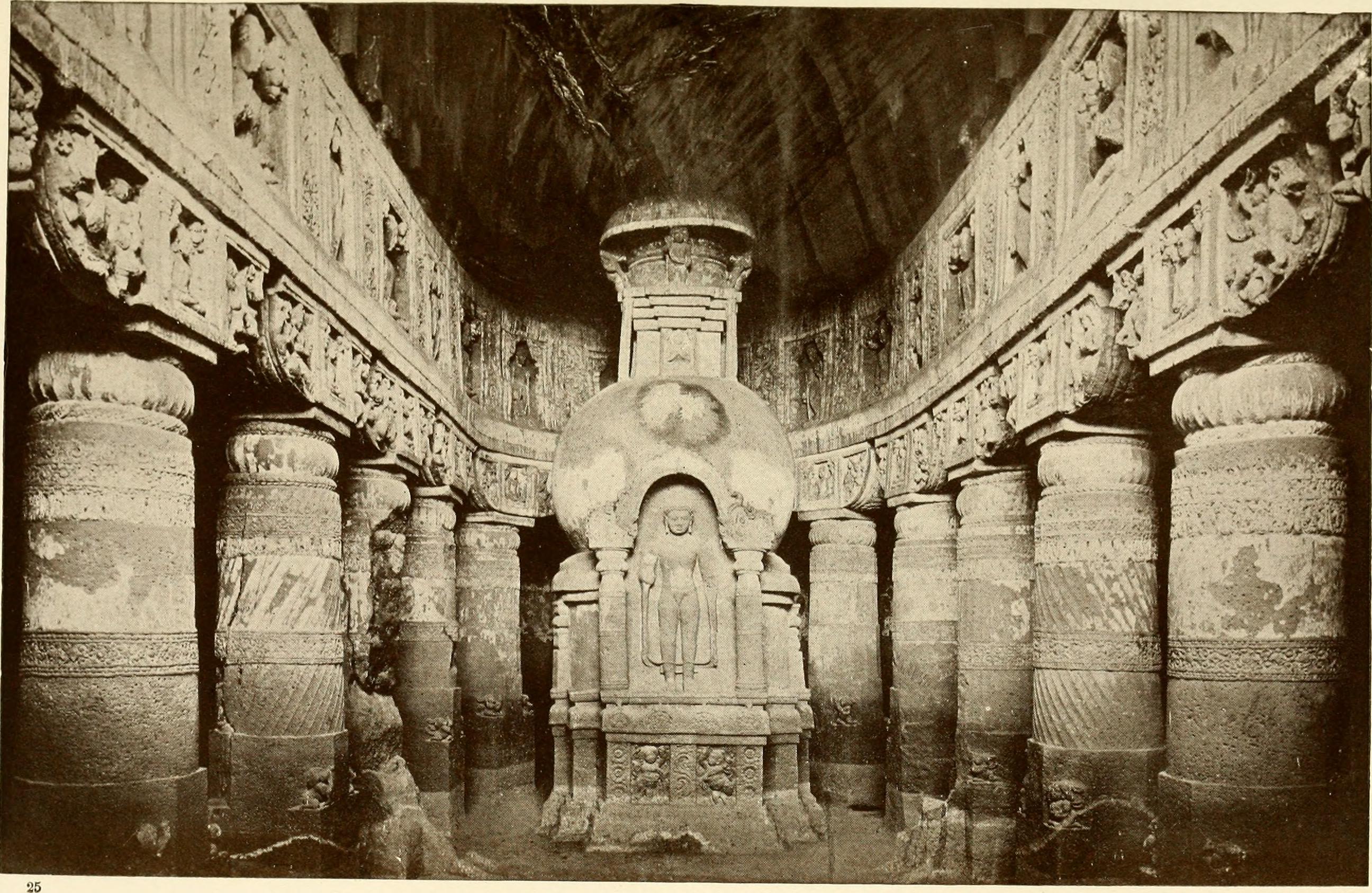
Chaitya hall,Cave 19, Ajanta,Maharashtra.
By Internet Archive Book Images [No restrictions], via Wikimedia Commons
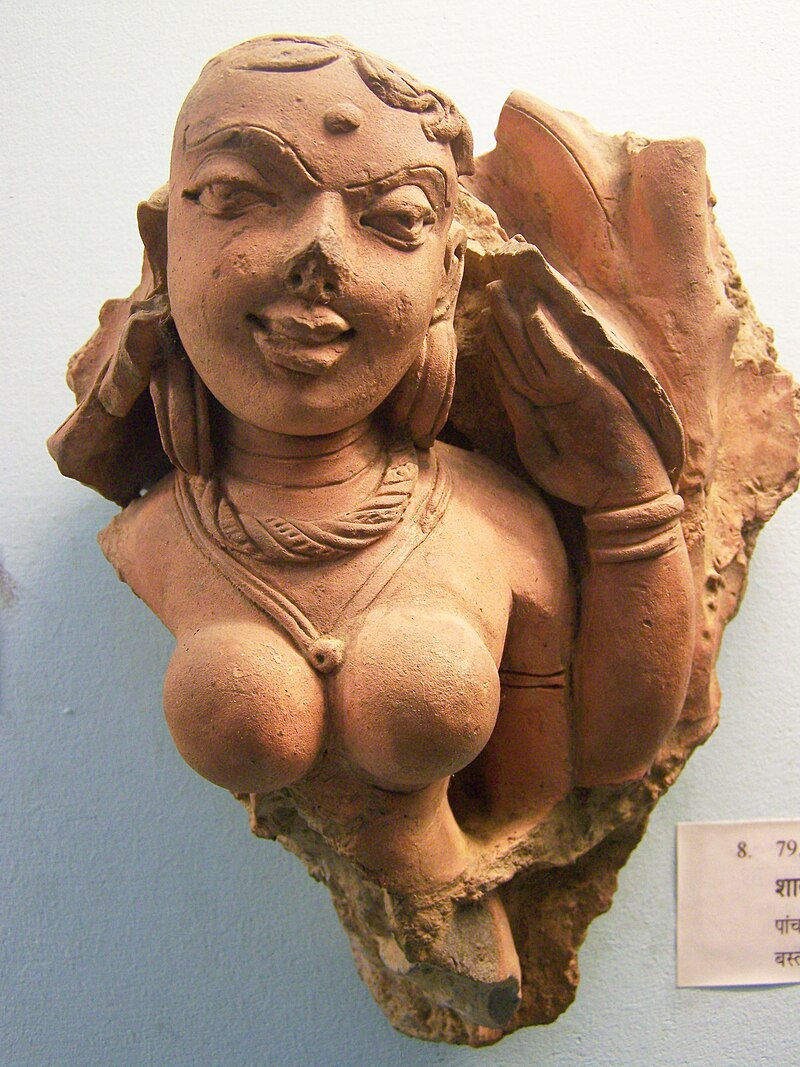
Shalabhanjika,terracotta,, 5th century, Gupta period,State Museum,Lucknow.
By Woudloper – Own work, CC BY-SA 4.0, https://commons.wikimedia.org/w/index.php?curid=36096802
They introduced new styles in architecture. In the 4th century the Mirpur Khas stupa was built having many arches. Another stupa Dhamek stupa at Sarnath is made of bricks. The Guptas made fine standing sculptural temples made from stone and brick. The stone Dasavatara temple at Deogarh has superb carvings. Other temples include the brick Parvati temple at Nachna in Madhya Pradesh

Dhamek stupa,Sarnath.
By R. M. Calamar from Brooklyn, New York, USA (Saranath Uploaded by Ekabhishek) [CC BY 2.0 (http://creativecommons.org/licenses/by/2.0)%5D, via Wikimedia Commons
Examples of Hindu art during the Gupta era are from the north central and north India. The temples built by the end of the fifth century had a well developed shikhara or superstructure. The Vishnu temple called the Dasavatara temple at Deogarh in Uttar Pradesh is from the early sixth century. The shikhara is not in a good state due to the ravages of time.
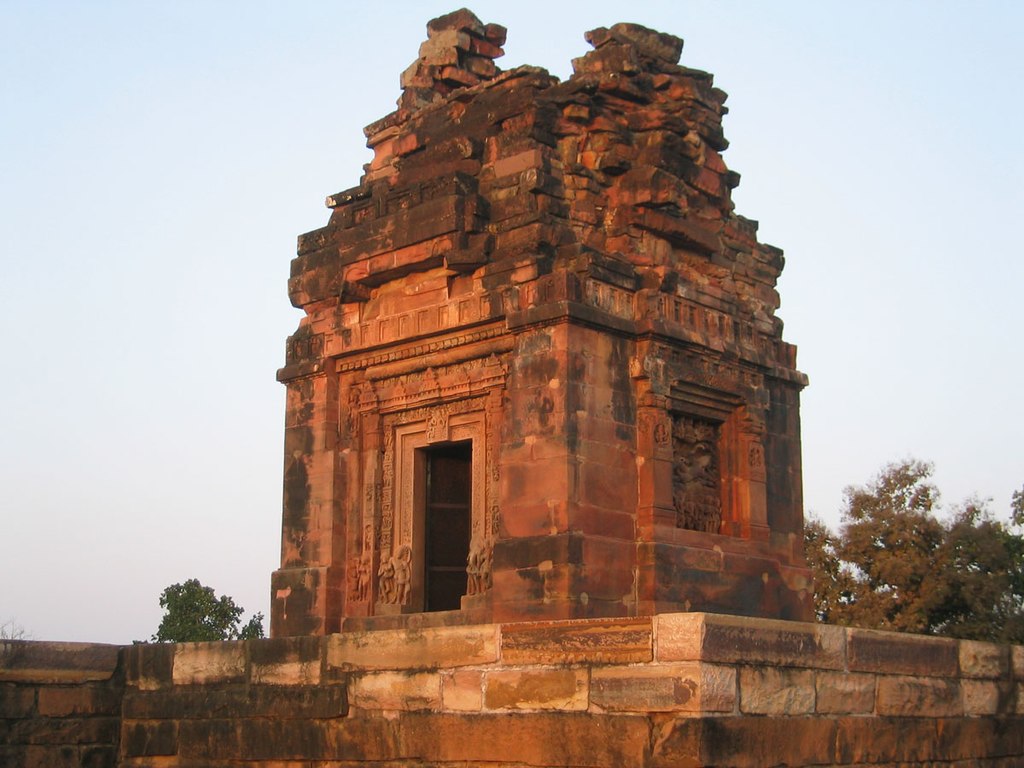
Dasavatara temple, Gupta period, Deogarh.
By byron aihara – originally posted to Flickr as deogarh01, CC BY-SA 2.0, https://commons.wikimedia.org/w/index.php?curid=8617319
The temple faces west with an elaborate doorway. Floral motifs, Ganga and Yamuna are at the top left and right of the doorway. Above the entrance is Lord Vishnu as Anantasayana. Further, Nara and Narayana depict the means through which moksa may be achieved and Gajendramoksa story is the final outcome and is on the north.
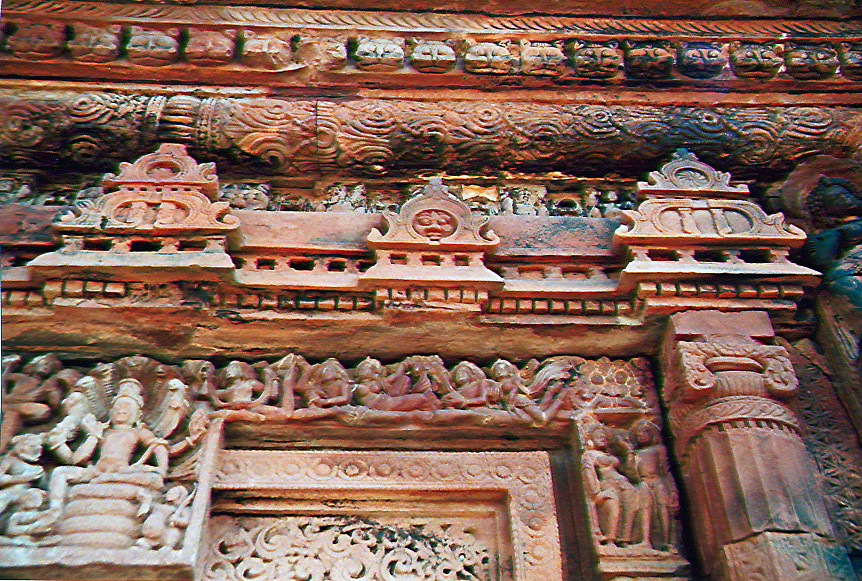
Lintel,Gupta period, Dasavatara temple,Deogarh,Uttar Pradesh.
By Bob King [CC BY 2.0 (http://creativecommons.org/licenses/by/2.0)%5D, via Wikimedia Commons
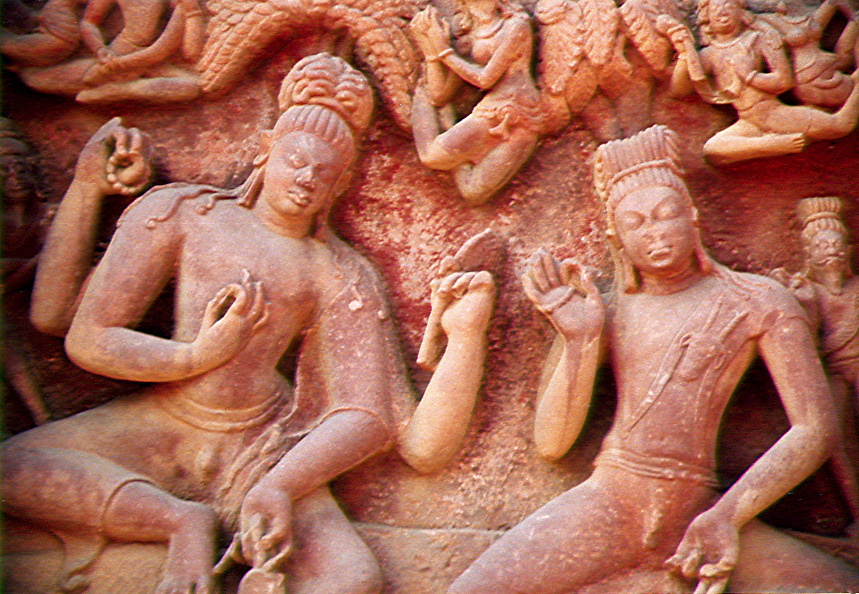
Nara-Naryana panel, Dasavatara temple, Gupta period,Deogarh.
By Bob King – originally posted to Flickr as 2705_Narayana_Detailfk.jpg, CC BY 2.0, https://commons.wikimedia.org/w/index.php?curid=6964968
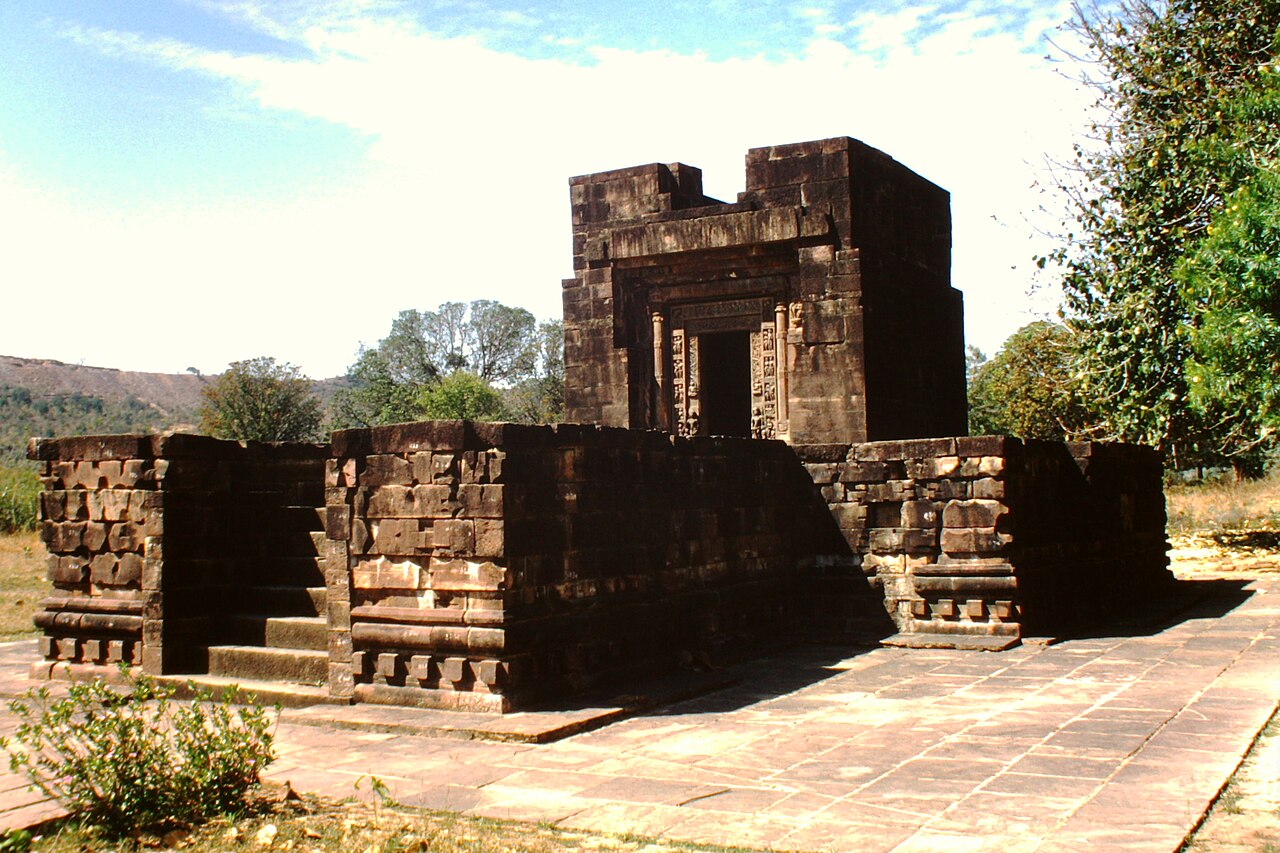
Parvati temple, Nachna, Madhya Pradesh.
By ArnoldBetten – Own work (Original text: eigenes Foto (Dia)), Public Domain, https://commons.wikimedia.org/w/index.php?curid=25359563
Vidisha was an important art centre especially during the reign of Chandragupta II (380-415 A.D) At Udayagiri a few km from Vidisha 20 rock cut caves are present. with inscriptions from his reign. Cave 6 at Udayagiri has a small camber with a rock cut verandah in front. The doorway has decorated pilasters,The goddesses Ganga and Yamuna are at the top of the pilasters. Two dwarapalas are at the sides of the doorway. The cave has Mahisarsuramardini on its facade, Ganesha is adjacent to the left wall next to the facade. Vishnu is carved between the dwarapalas on the left and Ganesha, between the dwarapalas on the right and Durga. Cave 5 is the Varaha cave which has the representation of Varaha, the boar avatar of Lord Vishnu.
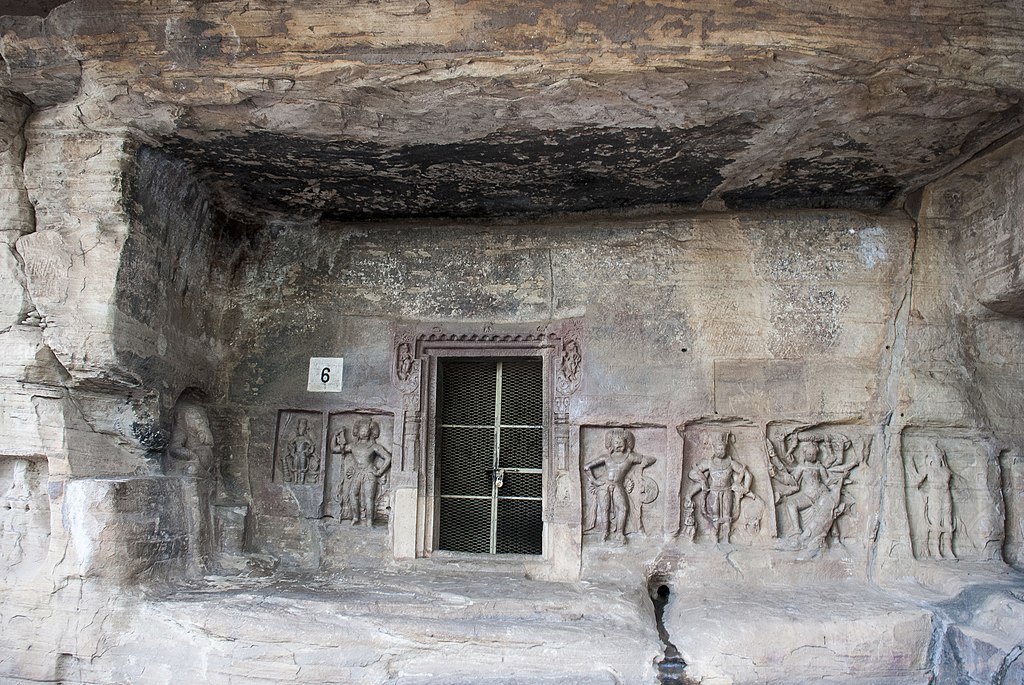
Cave 6,Udayagiri,Madhya Pradesh.
By © Asitjain / Wikimedia Commons, CC BY-SA 3.0, https://commons.wikimedia.org/w/index.php?curid=21676023

Cave 6, Udayagiri caves, Madhya Pradesh.
By Zippymarmalade – Own work, CC BY-SA 4.0, https://commons.wikimedia.org/w/index.php?curid=48503988
Examples of Buddhist art at Sanchi in Madhya Pradesh include the now world famous Great stupa which saw a lot of additions and modifications during the Gupta period,in the 5th century. A figure of Vajrapani capital near the northern gateway is at the Site Museum at Sanchi. Mahayana forms became prominent at this time. Cosmologically speaking, access to enlightenment is gained through the north. There are four Buddhas on all four sides. He is depicted in dhyana mudra, indicative of meditation.

Buddha statue, Great Stupa, Sanchi, Madhya Pradesh.
By Suvro Banerjee (Own work) [CC BY-SA 4.0 (http://creativecommons.org/licenses/by-sa/4.0)%5D, via Wikimedia Commons
During this time many new temples were added. At Sanchi is a temple called Temple 17 which is a well preserved small shrine. It has simple mandapa and a garbagriha. The temple has both Buddhist and Hindu architectural features.

Temple 17, Sanchi, Madhya Pradesh
By Ismoon (Own work) [GFDL (http://www.gnu.org/copyleft/fdl.html) or CC BY-SA 4.0-3.0-2.5-2.0-1.0 (http://creativecommons.org/licenses/by-sa/4.0-3.0-2.5-2.0-1.0)%5D, via Wikimedia Commons
Art at Mathura has flourished during the Kushana reign. which ended by the end of late third century. Many minor dynasties like the Nagas etc. took their place. The Nagas were defeated by Samudragupta and Mathura came under the Guptas. The Buddha images of Sarnath are carved in sandstone from Chunar. The Buddha is shown standing, having a slender body, relaxed with fluid lines. The style is a combination of the north-western and Indian stylisation of the human form. The sculptures must have been originally painted ones. The Buddha is mostly in the abhaya posture with a slightly bent leg. By the third quarter of the fifth century Sarnath had developed into an important Buddhist centre. Lord Buddha had given his first sermon here.The hand is lower compared to the Kushana sculptures. The drapery or cloth is very close around the body. The expression is gentle with eyes downcast .The dharmachakra mudra is also seen in some sculptures..

Standing Buddha, 5th century, Sarnath, Uttar Pradesh.
By Ismoon (talk) 11:48, 18 February 2013 (UTC) (Own work) [GFDL (http://www.gnu.org/copyleft/fdl.html) or CC BY-SA 4.0-3.0-2.5-2.0-1.0 (http://creativecommons.org/licenses/by-sa/4.0-3.0-2.5-2.0-1.0)%5D, via Wikimedia Commons

Standing Buddha, 5th century,Sarnath,Indian Museum,Kolkata.
By Photo Dharma from Penang, Malaysia – 090 Crowned Buddha, 5c, Sarnath, CC BY 2.0, https://commons.wikimedia.org/w/index.php?curid=37232665
The Mahabodhi temple at Bodhgaya which has been repaired many times is from the late Kushana or Gupta period. The original structure was built by Emperor Ashoka. At present the temple has a central shrine with a tall tower with four smaller shrines around it.
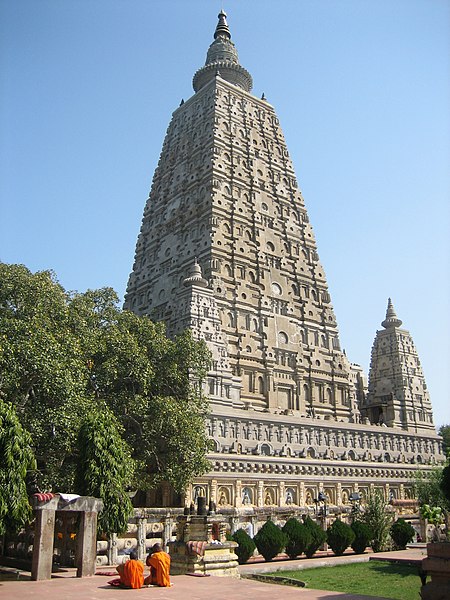
Mahabodhi temple, Bodh Gaya.
By Bpilgrim (Own work) [CC BY-SA 2.5 (http://creativecommons.org/licenses/by-sa/2.5)%5D, via Wikimedia Commons
Dated to the fifth century on the cliff-side are a series of caves excavated at Bamiyan in Afghanistan. At the end of the valley a tall 55m figure of Buddha and similar smaller Buddhas are located on the other side about a kilometre and half away.Smaller devotees accompany the Buddha figures. The large Buddha could be Vairocana and is believed to be associated with the cult of Brhad Buddha influenced by Indian Mahayana Buddhism.

Buddhas at Bamiyan, 5th century,Afghanistan.
František Řiháček [CC BY-SA 3.0 (http://creativecommons.org/licenses/by-sa/3.0)%5D, via Wikimedia Commons
At Bhitargaon is a well preserved structure of Gupta art from the first half of the fifth century. It is made of burnt bricks joined by mud mortar, the wall very thick. It is an east facing temple on a square jagati or plinth. There are niches on the exterior of the temple and the superstructure. There were many sculpted panels, many are now missing or partially destroyed. There are arches in the shrine and porch. Sculptures of this shrine have been similar to the ones at Ahichchattra in Uttar Pradesh, The Ganga and Yamuna figures originally were at the sides of a Shiva temple. Their costumes have tight bodices and heavy drapery. Their corresponding vahanas or vehicles, the makara and the tortoise are seen, also an attendant with parasol.

Goddess Ganga, Ahichchatra,Gupta period,National Museum, New Delhi.
By Miya.m (Miya.m’s file) [GFDL (http://www.gnu.org/copyleft/fdl.html) or CC BY-SA 3.0 (http://creativecommons.org/licenses/by-sa/3.0)%5D, via Wikimedia Commons

Lord Vishnu, 5th century, Mathura, State Museum, Lucknow,Uttar Pradesh.
By Woudloper – Own work, CC BY-SA 4.0, https://commons.wikimedia.org/w/index.php?curid=36096800
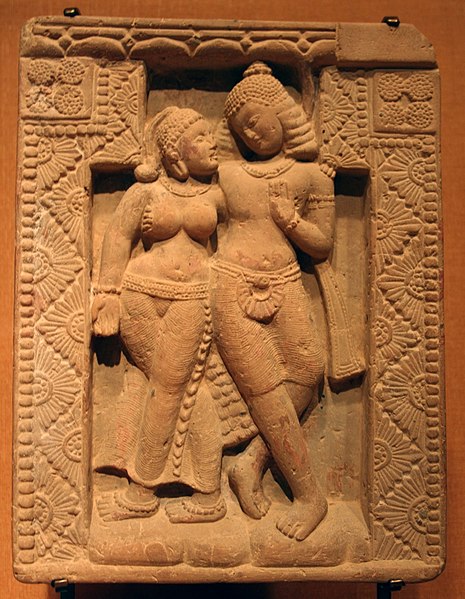
Mithuna (loving couple), terracotta,5th century. Honolulu Academy of Arts,USA.
By Wikipedia Loves Art participant “Department_of_Trife” [CC BY-SA 2.5 (http://creativecommons.org/licenses/by-sa/2.5)%5D, via Wikimedia Commons

Ramayana Scene,Gupta Art,Indian National Museum,New Delhi.
By Fotografía tomada por el Dr. Benjamín Preciado Centro de Estudios de Asia y África de El Colegio de México [GFDL (http://www.gnu.org/copyleft/fdl.html) or CC BY-SA 4.0-3.0-2.5-2.0-1.0 (http://creativecommons.org/licenses/by-sa/4.0-3.0-2.5-2.0-1.0)%5D, via Wikimedia Commons

Mother Goddess,Gupta period.
By Nomu420 (Own work) [CC BY-SA 3.0 (http://creativecommons.org/licenses/by-sa/3.0)%5D, via Wikimedia Commons

Dinar of Chandragupta II,4th century.
See page for author [Public domain], via Wikimedia Commons
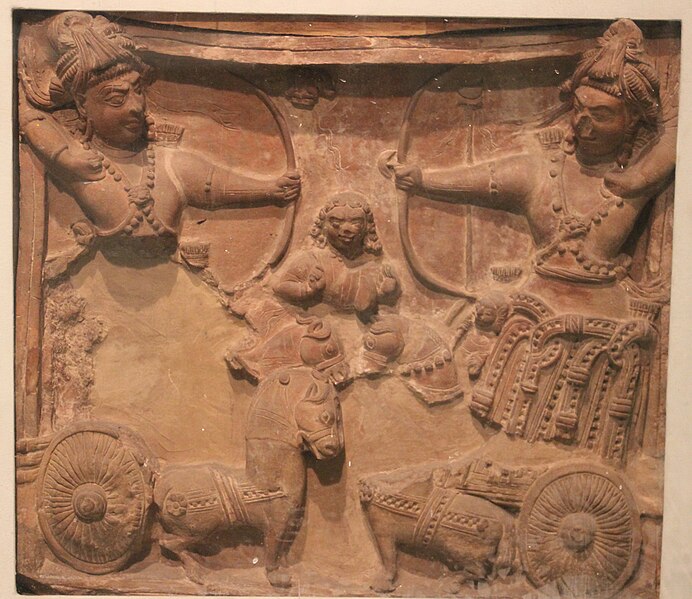
Mahabharata Scene, Gupta period,National Museum, New Delhi.
By Nomu420 (Own work) [CC BY-SA 3.0 (http://creativecommons.org/licenses/by-sa/3.0)%5D, via Wikimedia Commons
References :
- The art of ancient India/Huntington,Susan,New York : Weatherhill,1985.
- wikipedia.org
Posted by :
Soma Ghosh
©author

























